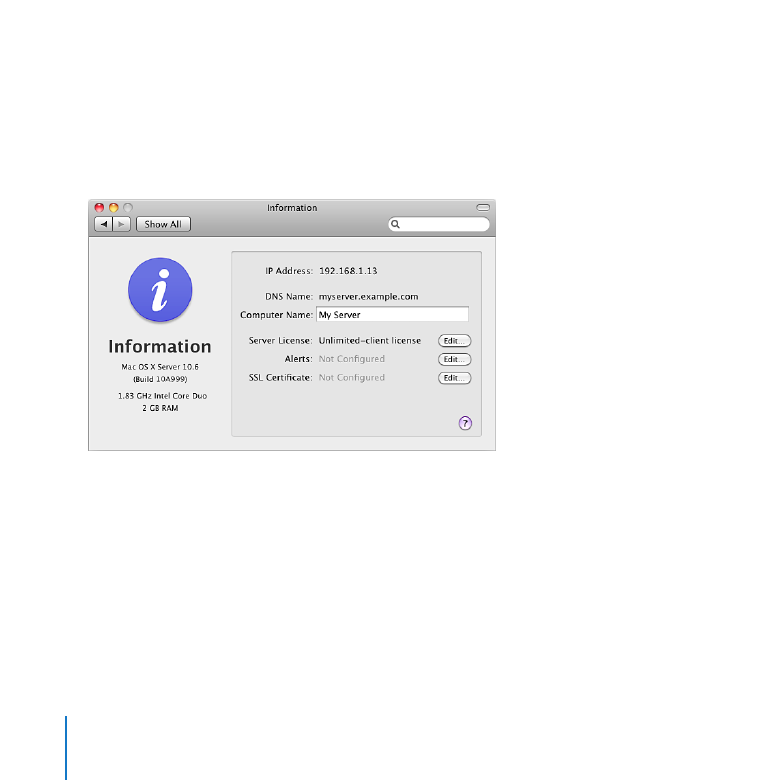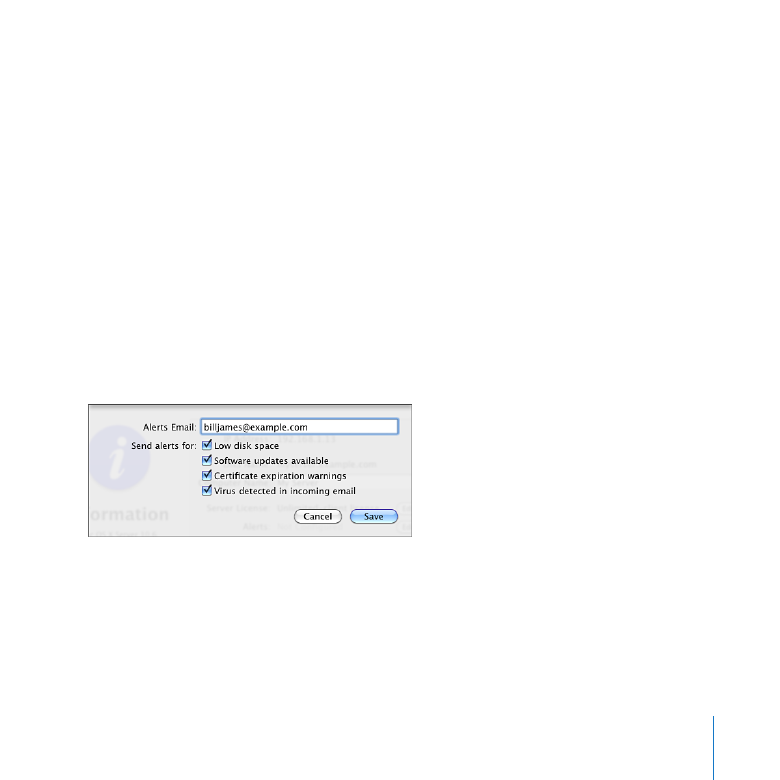
Managing Server Information
Managing Server Information
Use the Information pane of Server Preferences to get information about your server,
including the hardware and software installed, network names and address, and serial
number. You can also change the server’s computer name and serial number, manage
email alerts, and manage SSL certificates.
You can see and change other network information in the Network pane of System
Preferences on the server. For information about changing Network preferences, open
System Preferences and then use the Help menu.
You can get additional information about the server by using Apple System Profiler
(located in /Applications/Utilities/). For information about using System Profiler, open it
and then use the Help menu.

155
Chapter 10
Managing Server Information
Changing the Serial Number or Site License Details
You can use Server Preferences to change the Mac OS X Server software serial number
or site license information.
To change the software serial number or site license information:
1
In the Information pane of Server Preferences, click the Edit button next to the Server
License information.
2
Enter a different serial number or edit the site license details as needed, and then
click Save.
Changing Alert Settings
You can use Server Preferences to change the email address to which the server sends
warning messages about low disk space, software updates, expiring SSL certificates,
and email suspected of having a virus. You can also turn each type of alert on or off.
To change the notification email address:
1
In the Information pane of Server Preferences, click the Edit button on the Alerts line.
2
Enter the desired email address in the Alerts Email field.
If you don’t want any alerts sent, leave the Alerts Email field blank.
3
Select the types of alerts you want the server to send, and then click Save.

156
Chapter 10
Managing Server Information
Low disk space: Sends an email when a disk or partition has less than 5 percent free
space available.
Software updates available: Sends an email when new software updates become
available for the server.
Certificate expiration warnings: Sends an email when an SSL certificate is about to
expire.
Virus detected in incoming email: Sends an email when the email virus filter detects
a virus.
Changing Your Server’s Name
You can use Server Preferences to change the server’s computer name. This name
identifies the server to users who are browsing for network file servers or other
network resources identified by computer name rather than by DNS name.
To change your server’s computer name:
In the Information pane of Server Preferences, edit the Computer Name field.
m
Specify a name that’s 63 Roman characters or fewer, including spaces. Avoid using =, :,
or @. (If a user’s computer connects to the server using the SMB file sharing protocol,
Mac OS X Server automatically converts the computer name to a form that’s valid
with SMB.)

157
Chapter 10
Managing Server Information
To change the server’s local hostname, use the Sharing pane of System Preferences
on the server. Other computers on the server’s local network (IP subnet) can use
the server’s local hostname to contact the server. If you change your server’s local
hostname, users of other computers might need to change their bookmarks or other
settings to use the server’s new local hostname. For information about using System
Preferences, open it and use the Help menu.
Changing Your Server’s IP Address
The server’s IP address is one of the network connection settings in the Network pane
of System Preferences on the server. For information about changing the IP address in
Network preferences, open System Preferences on the server and use the Help menu.
If your server’s network connection is configured using DHCP, the server should have
a static IP address (the same IP address all the time) assigned by your DHCP server.
To change your server’s IP address in this case, the DHCP server must be reconfigured.
If you have an AirPort Base Station or other router that provides DHCP service, you
change your server’s IP address by reconfiguring the DHCP reservations or static
mapping feature.
Important:
After changing the server’s IP address, the DNS server for your network
must be updated so that your server’s DNS name points to the new IP address.
Also, a reverse lookup of the new IP address must point to your server’s DNS name.
If your server provides its own DNS service, you can use Server Admin to update it.
If your DNS service is provided by your ISP or another server on your network, ask your
ISP or the DNS server administrator to update your server’s DNS records.

158
Chapter 10
Managing Server Information
Changing your server’s IP address may disrupt the connections of users’ computers
that have Mac OS X v10.6 Snow Leopard. If this happens, users need to remove the
server from their list of directory servers and then add it back. For more information,
see “Setting Up a Mac by Using Accounts Preferences” on page 112.